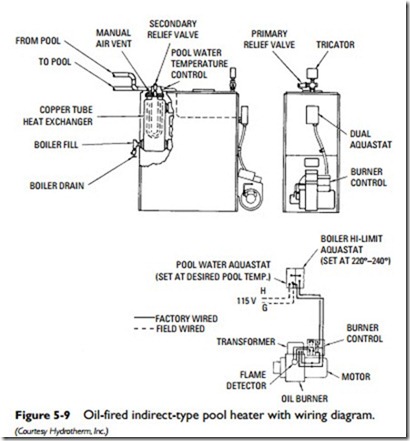Oil-Fired Pool Heaters
The oil-fired indirect pool heater illustrated in Figure 5-9 is available in several input ratings ranging from 175,000 Btu/h (1.25 gph firing rate) to 280,000 Btu/h (2.00 gph firing rate) with No. 2 fuel oil. The corresponding output ratings range from 133,000 Btu/h to 208,000 Btu/h, which gives this pool heater the capacity to heat swimming pools containing 16,000 to 25,000 gallons of water.
These pool heaters have a 100-psi ASME pressure rating, which makes possible their direct connection to city water lines without the use of pressure-reducing valves. The heat exchanger consists of multiple-pass finned copper tubes, which are designed for low-pres- sure drop and which can be removed for cleaning.
Figure 5-10 illustrates the recommended piping arrangement for this particular pool heater. Note that the filter is installed on the line from the pool between the pump (circulator) and the shutoff valve. No provision for bypass piping is made between the pipes leading to and from the pool. An example of bypass piping in a pool heating installation for a similar oil-fired indirect heater is shown in Figure 5-11.
The aforementioned pool heater is suitable for small residential pools. A typical 25,000-gallon pool is approximately 18 feet wide by 36 feet long if a rectangular-shaped pool is used as an example.
Pool heaters, whether oil-, gas-, or electric-fired, are available for almost any size pool. It is simply a matter of matching the pool size with the capacity of the pool heater. For example, Figure 5-9 shows an indirect oil-fired pool heater used for commercial applications, which is capable of heating a 105,000-gallon swimming pool. It has an input rating of 1,155,000 Btu per hour with 8.25 gph firing rate. This pool heater actually represents the combination of three heat- ing modules; each has its own oil burner and modulating aquastat.
